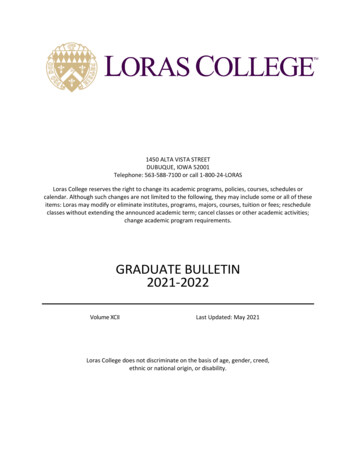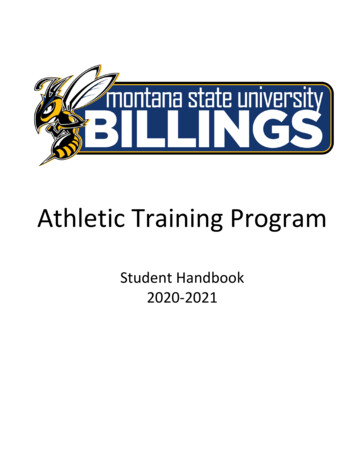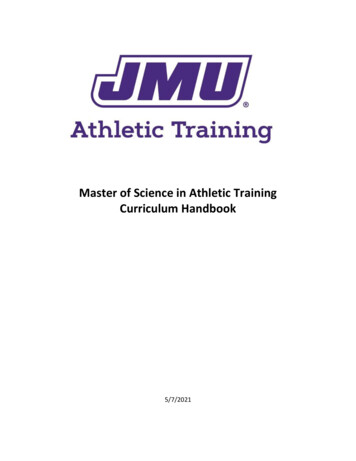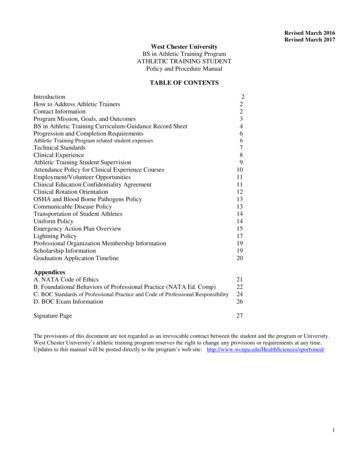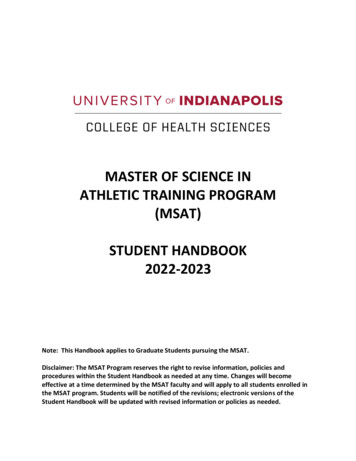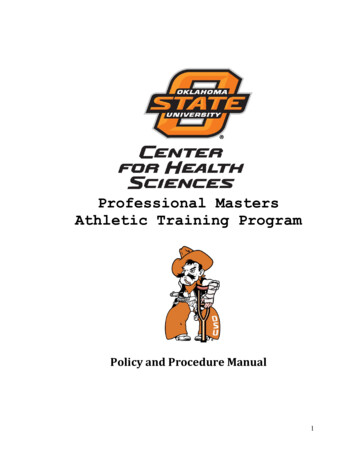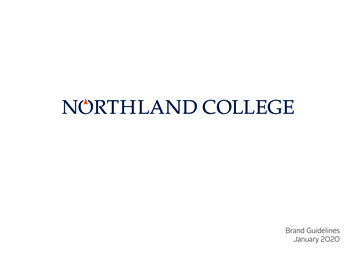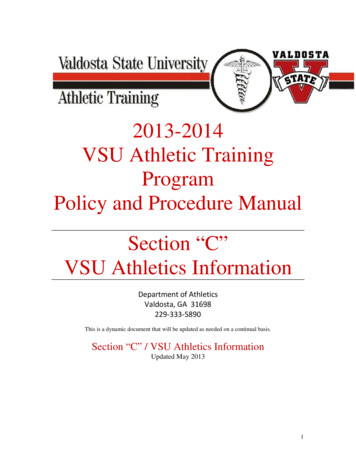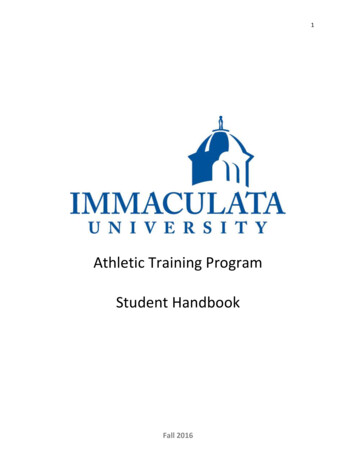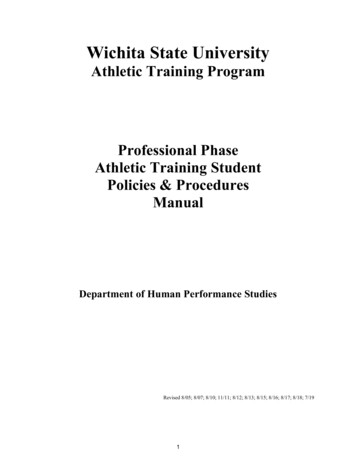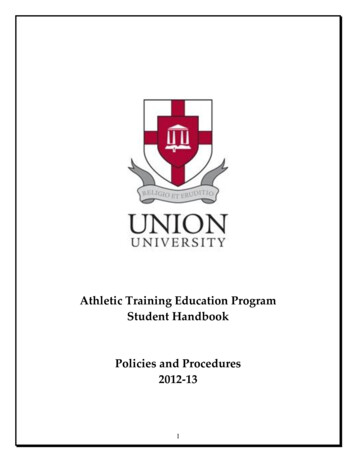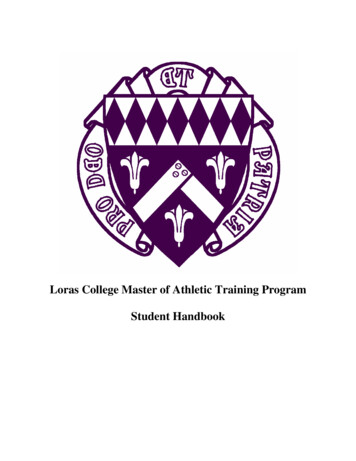
Transcription
Loras College Master of Athletic Training ProgramStudent Handbook
Table of ContentsIntroductionLoras College Mission StatementMaster of Athletic Training Program Mission, Outcomes & ObjectivesStudent Learning OutcomesCAATE Accreditation StatusProgram Personnel & ResponsibilitiesAthletic Training Faculty & StaffMaster of Athletic Training Program FeesAdmission Requirements and ProceduresAcceptance ProceduresProcedures for TransferringBackground Check, Drug Screen & Physical ExamTechnical StandardsRetention PolicyAcademic Probation StatusMAT Program Probation & Dismissal PolicyLoras Graduate Dismissal & Appeal ProcessProgram Graduation RequirementsResearch RequirementBOC Exam Testing & Approval Preparation ProceduresMaster of Athletic Training Program Required Course ListingCourse DescriptionsCurricular PlanClinical Education ExperiencesStudent ExpectationsAthletic ParticipationCAATE Standards (Clinical)Clinical Experience RequirementsAttendanceOrientationProficienciesSite VisitsEmergency Action PlansClinical Evaluation RequirementsHour DocumentationClinical Experience RotationsProfessionalism as an Athletic Training StudentPersonal Conduct Outside of SchoolTravelDress CodeCell Phone UsageCPR/AED CertificationLiability InsuranceNATA MembershipAdditional 192323242424262727272727272829303232323334343434
Outside EmploymentProfessional RelationshipsConfidentialityBBP Policy & ProcedureInfectious Disease Policy & ProcedureElectrical Modalities PolicyMandatory Reporting GuidelinesDisciplinary ActionsInfraction NotificationDisciplinary ActionsGrievance Policy & ProcedureGrade AppealsNon-Discrimination PolicySexual Harassment PolicyAwards & ScholarshipsSemester ProceedingsAppendicesTechnical Standards FormImmunization Review FormHIPAA & FERPA Confidentiality WaiverBloodborne Pathogen FormInfectious Disease FormMandatory Reporting FormStudent Infraction FormNATA Code of Ethics34353536384142444545464747484849Appendix AAppendix BAppendix CAppendix DAppendix EAppendix FAppendix GAppendix H1
IntroductionIn 1990, Loras College first offered an Athletic Training Internship Program with a major inPhysical Education. Beginning in the spring of 2000, Athletic Training became a major in theDivision of Physical Education and Sport Studies. It was initially recognized as an accreditedprogram in the fall of 2003 by the Commission on Accreditation of Allied Health EducationPrograms (CAAHEP). CAAHEP was replaced by the Commission on the Accreditation onAthletic Training Education (CAATE) in 2006. The Loras College ATP was re-accredited byCAATE during the fall of 2008 and was given full re-accreditation status for ten years. In thespring of 2014, a new athletic training faculty position was created. This person serves as the fulltime Clinical Education Coordinator for the program. During the 2014-2015 academic year, theprogram moved into the new Division of Molecular, Life, and Health sciences. This movealigned the program with the most similar programs on campus. Also, during the 2014-2015academic year, an entry-level Master of Athletic Training (MAT) program was proposed,designed, and approved by the college. The last cohort in the Bachelor’s entry-level athletictraining program was accepted in the spring of 2016. The first cohort of graduate athletic trainingstudents in the MAT program will be accepted in the fall of 2018.The Loras MAT program was designed to be distinctive from other entry-level programs due tothe strengths and educational backgrounds of the faculty in addition to the unique opportunitiesprovided on the Loras campus and in the Tri-State area. The faculty will provide a qualitybackground in athletic training based upon their varying career paths prior to entering academia.This includes a focus on health, wellness, and providing quality healthcare. This will allow thegraduate of the Loras MAT program to be prepared for the ever changing field of athletictraining. At the national level, the focus of athletic training is shifting toward a bigger seat at thetable with other allied healthcare providers. This is provided by the Loras MAT program throughthe 9 credits focused on health and wellness in both athletes and the general public.Additionally, the clinical experiences have been set up to provide quality experiences in ashortened time frame, and with immersive design.The purpose of this handbook is to inform you of the policies and procedures of our program.You are strongly encouraged to read this handbook several times each year. By reading thishandbook you will continue to be familiar with the roles and responsibilities that you have as anathletic training student, as well as decrease the chance of violating the policies and procedures.Once you have read and understood this information, please sign the MAT Student HandbookAcknowledgement form. In addition to this handbook, athletic training students must also readand be familiar with the policies, procedures, and resources provided by Loras College, andwithin the Loras College Graduate Student Bulletin.2
Loras College Mission StatementLoras, as a Catholic liberal arts college, creates a community of active learners, reflectivethinkers, ethical decision-makers and responsible contributors in diverse professional, social andreligious roles.Master of Athletic Training Program Mission, Outcomes & ObjectivesMAT Program MissionThe mission of the Loras College Master of Athletic Training Program is to produceactive learners, responsible contributors, and reflective thinkers that can provideexceptional healthcare to an active population through quality didactic and clinicalathletic training educational experiences.Program Assessment Plan: Goals, Objectives & Student Learning OutcomesStudent Learning Outcomes:1. Students will demonstrate comprehension of concepts and skills vital to basicfunction in health sciences careers.1.1 – express competency professional knowledge areas in athletic training – clinicalrotationClinical evaluationsScores on Five Domains of Board of Certification ExamsScores on Five Sub-sections of End of semester cumulative exams1.2 – recall foundational concepts in the health sciences – classroomEnd of semester cumulative examsFall cumulative test foundational areas, nutrition, biomechanics,physiology, anatomy, etc.Spring cumulative test professional areas completed2. Students will be be active learners and reflective thinkers who use common researchtechniques to discover and implement athletic training evidence based medicine.2.1 – read, reflect and summarize research related to athletic training clinicalpractice – classroomCritically Appraised Paper – Therapeutic Interventions ICritically Appraised Topic - Therapeutic Interventions IIFinal Research Paper2.2 – formulate clinical treatment plans using evidence based medicine – clinicalrotation3
Clinical evaluationsCritically Appraised Topic – Therapeutic Interventions II2.3 – use patient outcomes to determine quality of care – clinical rotationClinical evaluationsCapstone Patients3. Students will transition classroom knowledge into effective clinical practice.3.1 – employ prevention, diagnostic, treatment and rehabilitation techniques forinjuries and illnesses common in active populations – classroom and clinicalClinical evaluationsScores on Five Domains of Board of Certification ExamCapstone Patients3.2 – use administrative techniques common in healthcare – clinical rotationsClinical evaluationsScore on Single Domain of Board of Certification Exam4. Students will demonstrate professional communication skills in order to efficientlycommunicate with both patients and healthcare professionals throughout theprogram’s didactic and clinical education and in post-graduate settings.4.1 – utilize proper medical terminology in verbal and written communication –classroomCritically Appraised Paper – Therapeutic Interventions ICritically Appraised Topic – Therapeutic Interventions IIProgram Goals, Objectives, and Outcomes:2. The program will cultivate students who are active learners and reflective andimplement athletic training evidence based medicine.2.4 – preceptors will assist the students in the discovery and implementation ofevidencebased medicine in their practice. – Clinical rotationsStudent evaluationsClinical Coordinator evaluations2.5- Faculty will provide a classroom environment that allows students to growFaculty Assessment Scores4
Exit Interviews/Focus GroupsProgram Director EvaluationsCoordinator of Clinical Education EvaluationsAlumni Surveys3. The program’s didactic and clinical education will develop and educate studentswith the ability to be responsible contributors by transitioning classroom knowledgeinto effective clinical practice.3.1 – employ prevention, diagnostic, treatment and rehabilitation techniques forinjuries and illnesses common in active populations – classroom and clinicalAlumni SurveysEmployer Surveys3.2 – use administrative techniques common in healthcare – clinical rotationsAlumni surveys3.3 – preceptors will provide quality education opportunities. – Clinical rotationsStudent evaluationsClinical coordinator evaluations5. The program will ensure that graduates are prepared for autonomous practice as aCertified Athletic Trainer in post-graduate settings.5.1 – practice effectively in post graduate jobs and post-professional settingsAlumni surveysEmployer Surveys5.2 – demonstrate a BOC pass rate compliant with CAATE standardsBOC First Time Pass Rate5.3- demonstrate an acceptable post-graduate employment rateAnnual employment rateStudent Learning OutcomesClinical evaluations: completed by students and preceptors at the end of each clinical rotation,the Clinical Evaluation is first completed by the student (self-evaluation), and then sent to thePreceptor to be completed by the preceptor. The Preceptor then sends the completed evaluationelectronically to the Clinical Education Coordinator and the student and discusses the evaluationwith the student. For first year MAT students 3 clinical evaluations are completed at the end of5
each clinical education rotation, and for second year MAT students 3 clinical evaluations arecompleted at the end of each clinical education rotation. Clinical evaluations are an invaluableindicator that reveal if students are connecting educational professional knowledge learned in theclassroom with real-time patient experiences in the clinical education setting. Having an externalevaluator such as a preceptor is also incredibly helpful in relaying program strengths and areasfor improvement in education of professional knowledge areas.(Outcome & Objectives: 1.1, 2.2, 2.3, 2.4, 3.1, 3.2, 3.3)Board of Certification Exams: The BOC exam is taken by second year MAT students betweenJan-October which is during or after completion of their final semester as athletic trainingstudents. This culminating exam easily relays competency of the five domains of professionalknowledge in athletic training (Outcome & Objectives: 1.1, 3.1, 3.2)End of semester cumulative exams: The end of semester cumulative exam incorporatesinformation from all 5 domains of athletic training knowledge and all students in the programtake this exam during the final two weeks of the fall and spring semesters. Scores are expected tovary based upon student level in the program and content, with first year students fall scoresaiming for 70-80% is this first semester clinical cumulative exam focuses on foundationalknowledge. First year spring exam scores aim for the 60-70% range as this focuses onprofessional areas completed. Fall second year student exam scores should be over 70%. Thisexam is used as an indicator for progress in foundational and professional knowledge (5domains) areas of athletic training, and aids both students and educators in assessing areas ofstrength and weakness. For second year students the end of semester cumulative exam is also anindicator of readiness for the BOC exam. (Outcome & Objectives: 1.1, 1.2)Critically Appraised Paper - 1st Therapeutic Interventions course: Students complete thisresearch assignment in ATR 520 Therapeutic Interventions I during their first year fall semester.This assignment assesses the student's ability to read, reflect upon and summarize researchrelated to athletic training clinical practice, and also supports active learning and reflectivethinking in athletic training evidence based medicine.(Outcome & Objectives: 2.1, 4.1).Critically Appraised Topic - 2nd Therapeutic Interventions course: Students complete thisresearch assignment during their first year second semester in ATR 521 TherapeuticInterventions II. This assignment assesses the student's ability to read, reflect upon andsummarize research related to athletic training clinical practice, and also supports active learningand reflective thinking in athletic training evidence based medicine.(Outcome & Objectives: 2.1, 2.2, 4.1).Final Research Paper: Students complete this research assignment during their final semester inATR 680 Research in Athletic Training. This assignment assesses the student's ability to read,reflect upon and summarize research related to athletic training clinical practice, and alsosupports creation, administration and reporting on original research. This research assignmentand course supports active learning and reflective thinking in athletic training evidence basedmedicine. (Outcome & Objective: 2.1)6
Alumni surveys: Alumni surveys are sent electronically to the graduating cohort of studentswithin 1 year of graduation. Alumni survey questionnaires are sent to former students by theLoras ATP administrative assistant to ensure students may complete the survey anonymouslyand answer freely and honestly. The Loras administrative assistant then compiles data. Thealumni survey addresses a wide array of knowledge areas and assesses student readiness topractice in those areas. For the Loras ATP Assessment plan, alumni surveys specifically addressability to formulate treatment plans using evidence based medicine, use of patient outcomesurveys, faculty’s ability to prepare students to practice in athletic training, employment ofprevention, diagnostic, and therapeutic intervention techniques, administrative and professionalbehaviors, medical terminology, and overall ability to practice athletic training in a postbaccalaureate setting. (Outcome & Objectives: 2.2, 2.3, 2.5, 3.1, 3.2, 4.1, 5.1)Capstone Patients: Capstone Standardized patient simulations occur during the final semester inATR 606 Clinical Experience VI course. This is a week-long assignment where students areassigned to a simulated patient to evaluate, rehabilitate, and return to work or play over thecourse of the week. Patients are provided with scripts, and the PD or CEC attempts to attendeach session with the student and patient. Each day students are responsible for the properadministrative task of evaluating and documents the patient progression and correlatingrehabilitation. Documentation is submitted to the CEC daily during the week for grading andguidance. Capstone patients assist in the assessment of student ability to use patient outcomesurveys to determine quality of care, and also assesses the student’s ability to employ prevention,diagnostic, and therapeutic intervention techniques. (Outcome & Objectives: 2.3, 3.1)Student Preceptor Evaluations: At the end of each clinical education rotation students completean evaluation of their preceptor. This evaluation helps to ensure quality learning is occurring inthe clinical education setting, and students are connecting didactic and clinical education.Preceptor evaluations are compiled by the administrative assistant and shared with preceptorsannually in an anonymous manner. (Outcomes & Objectives: 2.4, 3.3)Clinical Coordinator Evaluations: On an annual basis, typically at the end of each academic year,preceptors and clinical education sites are evaluated by the Clinical Education Coordinator in aneffort to ensure a positive and educational learning environment is provided to students. TheCEC then shares the evaluation with the preceptor. Clinical Education Coordinator Evaluationsassist in the assessment of the preceptor’s ability to assist students in the discovery andimplementation of evidence based medicine and provide overall quality education opportunities.(Outcome & Objectives: 2.4, 2.5, 3.3)Faculty Assessment Scores: Loras ATP faculty have always been evaluated using IDEAassessment surveys at the end of each semester for each course that is taught. The IDEA ratingsystem is an excellent tool measuring if Faculty are scored as above average in teaching, and alsoto show if each individual course is scored as above average by students. (Outcomes &Objective: 2.5).Exit Interviews/Focus Groups: Exit surveys are sent electronically to all students graduatingfrom the MAT program near the end of their final semester. Surveys are sent electronically bythe ATP administrative assistant, completed by the student, and returned to the ATP7
administrative assistant for data compilation. Data is then used to determine how students ratedthe program. (Outcomes & Objective: 2.5)Program Director Evaluations: The MAT Program Director will annually evaluate faculty whoteach didactic courses in the MAT program. This data will serve to support a positive educationalclassroom environment that allows students to grow, learn and adequately prepare to serve asCertified Athletic Trainers. (Outcome & Objective: 2.5)Employer Surveys: Employer surveys are sent to current employers of Loras ATP Alumni withthe permission of the Alumni typically within 1 year following graduation from the MATprogram. Employer surveys assist in the assessment of the former student’s ability to employprevention, diagnostic, and therapeutic intervention techniques and their overall ability topractice effectively in post baccalaureate settings. (Outcome & Objectives: 3.1, 5.1)CAATE Accreditation StatusThe Loras College Athletic Training Program was initially accredited by the Commission onAccreditation of Allied Health Education Programs (CAAHEP) in the fall of 2003. Effective July1, 2006, existing CAAHEP accredited programs were transitioned into the new accreditingagency, or the Commission on Accreditation of Athletic Training Education (CAATE). TheLoras College AT Program was re-accredited by the CAATE as of 2008 for 10 years, throughthe 2018-2019 academic year. The program underwent re-accreditation procedures during the2018-2019 academic year and also underwent substantive change procedures as it transitions tograduate degree status. The Loras Athletic Training Program was granted the change in degreestatus to a graduate degree program in the fall of 2018 by the CAATE. The same academic year,the CAATE conducted a comprehensive review and site visit and the program was re-accreditedby the CAATE for 10 years, through the 2028-2029 academic year.Personnel & ResponsibilitiesThe Athletic Training Program consists of administration, faculty athletic trainers, preceptors,team physicians, consulting medical specialists and graduate assistants.Loras College ProvostThe Provost is responsible for providing leadership to all academic programs and personnel. TheProvost also participates in overall planning, implementation, and assessment of college-wideinitiatives.Director of Graduate and Continuing Education ProgramsThe Director of Graduate and Continuing Education Programs oversees all aspects of graduateprogramming. This individual reports directly to the Provost.Loras College Molecular, Life and Health Sciences Division ChairThe Molecular, Life and Health Sciences (MLHS) Division Chair oversees all academicprograms and personnel within the MLHS division. The MLHS Division Chair reports directly tothe Provost.8
Athletic Training Program DirectorThe MAT Program Director is responsible for the day-to-day operation, coordination,supervision, and evaluation of all aspects of the MAT Program. The program director reports tothe MLHS Division Chair, and Provost.Athletic Training Coordinator of Clinical EducationThe clinical experience coordinator (CEC) is responsible for the administration and managementof the clinical education and clinical experience components of the MAT program. The CECassists the program director in the day to day operation of the program. The clinical educationcoordinator reports directly to the MLHS Division Chair.Athletic Training Research CoordinatorThe athletic training research coordinator is responsible for coordinating the activities within theathletic training research laboratory. The coordinator is responsible for the organization of thelaboratory as well as overseeing all of the research programs within the MAT Program.Athletic Training FacultyThe athletic training faculty members are considered core faculty and teach within the MATProgram. The faculty assists the program director in the day to day operation of the program.Supporting FacultyThe supporting athletic training faculty are those professors that teach supporting (pre-requisite)curricular courses such as Anatomy and Physiology, Physiology of Exercise, and Nutrition. Thesupporting faculty work closely with the AT Program director to assure that proper competenciesare taught in each course when necessary.Adjunct InstructorsLoras College employs adjunct instructors when necessary. These instructors primarily teachcourses within the Loras Kinesiology program, however may occasionally be needed in AthleticTraining Courses.Loras College Head Athletic TrainerThe Loras Head Athletic Trainer is responsible for overseeing all of the athletic training servicesat Loras. The Head Athletic Trainer reports to the Loras Athletic Director, but works closelywith the Loras AT Program director on education related matters. The Head ATC can serve as aMAT program preceptor.PreceptorsPreceptors are health care professionals who have completed the Loras College MAT ProgramPreceptor training and are an appropriately credentialed health care professional. Theseindividuals are qualified to supervise clinical instruction during the clinical education courseswithin the curriculum and can also supervise the athletic training students during clinicalexperiences. The preceptors who supervise athletic training students during their main clinicalexperience rotations will be credentialed as Certified Athletic Trainer’s or Physicians, and willbe responsible for evaluating Athletic Training Students and required Clinical Proficiencies.9
These should be assessed in real-time as often as possible. Additional supplemental clinicalexperience opportunities may involve the supervision other credentialed health careprofessionals.Medical Director(s)The medical director(s) advises the athletic training program director in the education of athletictraining students. He/she is directly involved in the athletic training student’s education byfrequently interacting with the students through guest lectures, surgical observations, practiceand game attendance, as well as through other means.MLHS Division SecretaryThe MLHS Division Secretary assists faculty and staff with the daily operations of the MATprogram. The secretary reports to the MLHS Division Chair.Athletic Training Students (ATS’s)Athletic training students are those students whom have been accepted into the MAT Programand are current MAT Graduate Students.Observation StudentsObservation students are prospective athletic training students who have not been accepted intothe MAT Program. These students may not, at any time, perform athletic training skills onpatients while observing for hours required to be admitted to the program. Although an exposureis highly unlikely, these students must undergo OSHA or blood borne pathogens training, as wellas FERPA training, prior to observing Loras or affiliated athletic trainers or athletic trainingstudents.Athletic Training FacultyLoras College Master of Athletic Training (MAT) Program1450 Alta VistaLC Mail Box #148Dubuque IA, 52001563-588-7995NameMolly Figgins, ABD, ATCMAT Program Director &FacultyMegan Beard, PhD, ATCMAT Clinical EducationCoordinator & facultySharon Feld, EdD ATCMAT FacultyAddressPhoneGraber Office #204LC Mail Box #148Dubuque IA, 52001Graber Office #203LC Mail Box #148Dubuque IA, 52001Keane Office # 26LC Mail Box #148Dubuque IA, ras.edu10
Master of Athletic Training Program FeesLoras College Graduate Tuition and Fee information can be located at:https://www.loras.edu/financial-aid/Additional MAT Program Fee Estimates (these fees are subject to change):ItemTyphon Software MembershipClinical Education Fee per credit hour forATR 601-603 & 605-606ATR 604 General Medical ClinicalLiability InsuranceEquipment & Clothing Fees (vary by student)BOC Practice Exam (s)CPR Certification (every other year)Background Check & Drug ScreeningNATA Student MembershipClinical Education TravelEstimated Cost 90 21 (subject to change) 100 40 100 30 40 135 80 (annually)TBDTyphon is a web-based software program designed specifically for CAATE-accredited programsthat facilitates student and program assessment. Enrollment in Typhon and payment of the onetime fee provides student access to the program for 5 years and includes educational tools toassist students in their academic progression in the program, and prepare them for employmentpost-graduation.The CAATE accreditation standards require that students purchase a liability insurance policyduring the professional phase of the entry level program. This requirement is consistent acrossall entry level programs regardless of level (bachelors or masters). Information regarding thepurchase of liability insurance can be obtained from the MAT Program Director.Admission Requirements and ProceduresEligibility: Strong academic ability, evidenced by a cumulative undergraduate GPA of at least 3.0. Completion of the following prerequisite course requirements before the start of theprogram:o Principles of Biology Io General Chemistry Io Anatomy & Physiology Io Anatomy & Physiology IIo Nutritiono Lifespan Developmento Biomechanicso Statistics11
o Physics Io Exercise PhysiologyAll students must apply through the ATCAS web-site. Applicants must submit the followingapplication materials:1) Visit the ATCAS website: https://caate.net/apply-now/, click on “Apply Now” button,then click “Create Account”, and complete the online application. (Preferred browsers areGoogle Chrome or Firefox).2) As part of the ATCAS application, we require you to submit the following supplementaldocuments:a. Official transcripts from each institution attendedi. Download a Transcript Request Form in the “Academic History” section ofyour ATCAS online application for each institution attended. Send the RequestForm to the Registrar’s Office of each institution (along with any associatedtranscript fee). The Registrar’s Office will then send your official transcriptdirectly to ATCAS.b. Two Letters of Recommendationi. Create two Recommendation Requests in the “Supporting Information” sectionof your ATCAS online application, which will then be emailed to your references.Your references will upload their recommendation directly to an Evaluator Portalwhich will then automatically get sent to ATCAS.ii. One of the letters needs to be from a Certified Athletic Trainer.c. Personal Statementi. The typewritten personal statement should outline your professional goals, bothshort-term and long-term, including why you have chosen Athletic Training as acareer (maximum two pages double-spaced). Upload this file to the “SupportingInformation” section of your ATCAS online application.d. Resumei. Upload this file to the “Supporting Information” section of your ATCAS onlineapplication.e. Completed Observation Hour Logi. Students must complete observation hours in two different Athletic Trainingsettings with two different Certified Athletic Trainers (ATC). Examples ofdiffering settings include but are not limited to: high school, college or university,clinics, industrial, professional or minor league sports. A total of 50 observationhours are required by December 1. Each athletic trainer observed will need to signan Observation Hour Log form. Upload your completed Observation Hour Logform to the “Documents” tab within the “Program Materials” section of yourATCAS online application. (You do not need to manually enter your observationhours in the “Supporting Information” section).12
Acceptance ProceduresApplication Deadline:Summer cohort enrollment: the ATCAS online application should be submitted and allsupplemental application documents should be received by December 1. Applications submittedafter the deadline will be considered on an individual basis.Interview and Admission Decision:We have rolling admissions for this program (up until the deadline), therefore after yourapplication is complete and verified in ATCAS, your file will be reviewed by the ProgramDirector to determine whether to move forward with an interview. You will then be contactedwith information about your next steps. After completion of your interview (or after review ofyour file), you will be notified of an admission decision via email within two weeks.Please note that acceptance is contingent upon the completion of the following items: Evidence of a valid American Red Cross CPR/AED certification for the ProfessionalRescuer OR American Heart Association Lifesaver Certification OR an equivalentcertification from another organizationMust pass a routine background check and drug screeningMust sign a technical standards form (See Appendix A)Must purchase professional liability insuranceMust complete a routine physical examinationImmunization Review verifying MMR, Tdap, 1st in series of 3 hepatitis B, and theCOVID-19 vaccines co
academic year, an entry-level Master of Athletic Training (MAT) program was proposed, designed, and approved by the college. The last cohort in the Bachelor's entry-level athletic training program was accepted in the spring of 2016. The first cohort of graduate athletic training students in the MAT program will be accepted in the fall of 2018.
